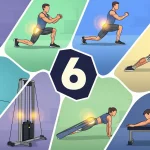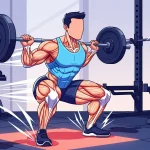Hey Fit People, ever had this happen?
You’re deadlifting 100 kg. Your back and legs still feel strong, but your grip? It’s giving up. The bar’s slipping, your hands are sweating and shaking though your muscles could go for more then boom… failed lift.
That, right there, is when gym straps aren’t just accessories they’re game changers.
But unfortunately, many people still think using straps is cheating, unnatural, or just for show.
In reality? It’s the opposite. When you understand when and why to use straps, your performance can break through the limits that your hands couldn’t handle on their own.
Let’s break it down, what gym straps are, and why they’re always in a pro lifter’s bag.
What Are Gym Straps and Why Do Lifters Swear by Them?
Gym straps are supportive tools usually thick cotton, synthetic leather, or nylon straps wrapped around your wrists and the barbell to help you hold on tighter and prevent slipping.
There are different types:
- Figure 8 Straps – perfect for ultra-heavy deadlifts
- Classic Loop Straps – most common in gyms
- Hook Straps – metal hook attached for max grip support
Think of them like seatbelts in a sports car. You don’t always need them, but when you’re speeding? You’ll be glad you wore one.
Why Grip Can Be Your Weak Link
Let’s be honest… sometimes, it’s because you’ve got small hands. (Okay, kidding… kinda.)
Physiologically, your back, legs, and glutes are way stronger than your forearms and grip. That’s why even the strongest lifters can feel their hands giving out first, not because their body is weak, but because grip fatigue kicks in.
A 2011 study from the Journal of Strength & Conditioning Research found that using lifting straps can increase deadlift capacity by 10–15%, simply because grip is no longer the limiting factor.
But What If You Use Straps All the Time?
If you use straps on every single set, even for light weights… you’ll never build true grip strength.
That leads to weak hands, harder pull-ups, and more risk of wrist or hand injury down the line.
It’s like always taking the escalator when there are stairs. You might save energy now, but your legs won’t thank you later.
When to Use (and NOT Use) Straps
✅ USE them when:
- Heavy deadlifts (1–5 reps)
- Romanian Deadlifts (RDL) for hamstrings
- Max-effort barbell rows
- Final pulling sets when your hands are giving up
❌ AVOID them when:
- Light-weight, high-rep sets (12–20 reps)
- Technique/form training
- Grip-focused exercises (farmer walks, static hangs)
Straps aren’t for cheating. They’re tools to help you focus on your target muscles, not fight with your grip.
Common (and Silly) Strap Mistakes
- Wrapping them wrong → bar feels even slipperier
- Using them from your first set → no grip adaptation
- Thinking you’re “cheating” because your gym buddy said so 🤭
- Using straps for bicep curls or lateral raises → bro… why?
Straps vs Chalk vs Gloves: Which One Helps Most?
| Tool | Main Function | Best For |
|---|---|---|
| Straps | Extra grip support | Deadlifts, RDLs, heavy pulling |
| Chalk | Sweat absorption | Olympic lifts, pull-ups |
| Gloves | Hand protection | Light training, beginners, high reps |
Quick Insight:
- Chalk = sweat control
- Straps = performance boost
- Gloves = comfort and callus prevention
Who Should Be Using Straps?
- Lifters who’ve hit a plateau because of grip
- Those who want to target their back, not just train their forearms
- Athletes chasing a new PR and need all the support they can get
Bottom line: When used wisely, straps don’t mean you’re cheating, they mean you’re smart.
Final Take: Show-Off or Smart Strategy? It’s on You.
You can absolutely lift without straps and that’s fine.
But you might also miss out on your true potential just because you’re trying to stay natural.
If your target muscles can keep going but your grip is waving the white flag, why not give yourself the help you need?
At Focus Fit, you can explore the proper use of training tools like straps with guidance from experienced trainers.
Because #StayFocus isn’t about who lifts the hardest, It’s about knowing when to go full throttle, and when to buckle up with your seatbelt.
References:
- Journal of Strength and Conditioning Research, 2011. “Effects of Lifting Straps on Deadlift Performance.”
- Harvard Health Publishing. “Why Grip Strength Matters More Than You Think.”
- American Council on Exercise (ACE). “Weightlifting Accessories: Straps, Gloves, and Belts.”





